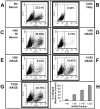An AGM model for changes in complement during pregnancy: neutralization of influenza virus by serum is diminished in late third trimester
- PMID: 25409303
- PMCID: PMC4237339
- DOI: 10.1371/journal.pone.0112749
An AGM model for changes in complement during pregnancy: neutralization of influenza virus by serum is diminished in late third trimester
Abstract
Pregnant women in the third trimester are at increased risk of severe influenza disease relative to the general population, though mechanisms behind this are not completely understood. The immune response to influenza infection employs both complement (C') and antibody (Ab). The relative contributions of these components to the anti-viral response are difficult to dissect because most humans have pre-existing influenza-specific Abs. We developed the African green monkey (AGM) as a tractable nonhuman primate model to study changes in systemic innate immunity to influenza during pregnancy. Because the AGMs were influenza-naïve, we were able to examine the role of C' in influenza virus neutralization using serum from non-pregnant animals before and after influenza infection. We determined that serum from naïve AGMs neutralized influenza via C', while post-infection neutralization did not require C', suggesting an Ab-mediated mechanism. The latter mimicked neutralization using human serum. Further, we found that ex vivo neutralization of influenza with both naïve and influenza-immune AGM serum occurred by virus particle aggregation and lysis, with immune serum lysing virus at a much higher rate than naïve serum. We hypothesized that the anti-influenza C' response would diminish late in AGM pregnancy, corresponding with the time when pregnant women suffer increased influenza severity. We found that influenza neutralization capacity is significantly diminished in serum collected late in the third trimester. Strikingly, we found that circulating levels of C3, C3a, and C4 are diminished late in gestation relative to nonpregnant animals, and while neutralization capacity and serum C3a return to normal shortly after parturition, C3 and C4 levels do not. This AGM model system will enable further studies of the role of physiologic and hormonal changes in downregulating C'-mediated anti-viral immunity during pregnancy, and it will permit the identification of therapeutic targets to improve outcomes of influenza virus infection in pregnant women.
Conflict of interest statement
Figures







Similar articles
-
Maternal immune response and neonatal seroprotection from a single dose of a monovalent nonadjuvanted 2009 influenza A(H1N1) vaccine: a single-group trial.Ann Intern Med. 2011 Dec 6;155(11):733-41. doi: 10.7326/0003-4819-155-11-201112060-00005. Ann Intern Med. 2011. PMID: 22147712 Clinical Trial.
-
Resistance to complement-mediated lysis of parainfluenza virus 5-infected cells is acquired after transition from acute to persistent infection.J Virol. 2025 Feb 25;99(2):e0189524. doi: 10.1128/jvi.01895-24. Epub 2025 Jan 10. J Virol. 2025. PMID: 39791880 Free PMC article.
-
Synergy between the classical and alternative pathways of complement is essential for conferring effective protection against the pandemic influenza A(H1N1) 2009 virus infection.PLoS Pathog. 2017 Mar 16;13(3):e1006248. doi: 10.1371/journal.ppat.1006248. eCollection 2017 Mar. PLoS Pathog. 2017. PMID: 28301559 Free PMC article.
-
Hormonal Regulation of Physiology, Innate Immunity and Antibody Response to H1N1 Influenza Virus Infection During Pregnancy.Front Immunol. 2018 Oct 29;9:2455. doi: 10.3389/fimmu.2018.02455. eCollection 2018. Front Immunol. 2018. PMID: 30420854 Free PMC article. Review.
-
Safety of oseltamivir in pregnancy: a review of preclinical and clinical data.Drug Saf. 2010 Aug 1;33(8):631-42. doi: 10.2165/11536370-000000000-00000. Drug Saf. 2010. PMID: 20635821 Review.
Cited by
-
Role of hormones in the pregnancy and sex-specific outcomes to infections with respiratory viruses.Immunol Rev. 2022 Jul;308(1):123-148. doi: 10.1111/imr.13078. Epub 2022 Apr 4. Immunol Rev. 2022. PMID: 35373371 Free PMC article. Review.
-
Influenza in High-Risk Hosts-Lessons Learned from Animal Models.Cold Spring Harb Perspect Med. 2020 Dec 1;10(12):a038604. doi: 10.1101/cshperspect.a038604. Cold Spring Harb Perspect Med. 2020. PMID: 31871227 Free PMC article. Review.
-
The complement system and adverse pregnancy outcomes.Mol Immunol. 2015 Sep;67(1):56-70. doi: 10.1016/j.molimm.2015.02.030. Epub 2015 Mar 21. Mol Immunol. 2015. PMID: 25802092 Free PMC article. Review.
References
-
- Billington WD (2003) The immunological problem of pregnancy: 50 years with the hope of progress. A tribute to Peter Medawar. J Reprod Immunol 60: 1–11. - PubMed
-
- Arck PC, Hecher K (2013) Fetomaternal immune cross-talk and its consequences for maternal and offspring's health. Nat Med 19: 548–556. - PubMed
Publication types
MeSH terms
Substances
Grants and funding
LinkOut - more resources
Full Text Sources
Other Literature Sources
Miscellaneous

